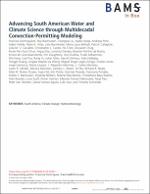Advancing South American Water and Climate Science through Multidecadal Convection-Permitting Modeling
Metadata
Show full item recordAuthor(s)
Date
2024-01-08Collections
- Artículo científico [171]
Related Resource(s)
https://www.senamhi.gob.pe/load/file/02270SENA-280.pdfAbstract
South America’s hydroclimate sustains vibrant communities and natural ecosystems of extraordinary biodiversity including the Andes Cordillera, and the Orinoco, La Plata, and Amazon basins. Global warming and land-use change are endangering ecosystem health, exacerbating hydrometeorological extremes, and threatening water and food security for millions of people on the continent (Castellanos et al. 2022). Reductions in rainfall and streamflow have been observed in southern Amazonia, the Cerrado region, northeast Brazil, and Chile (Muñoz et al. 2020; Garreaud et al. 2020; Espinoza et al. 2019; Fu et al. 2013). The increased aridity has affected agricultural yield, water supply for reservoirs, hydropower generation and impacted tens of millions of people in the large metropolitan areas of Sao Paulo, Rio de Janeiro, and Santiago de Chile (Nobre et al. 2016). Andean glaciers, an important source of water, have lost 30% of their area in the tropics and up to 60% in the southern Andes—the highest glacier mass loss rates in the world (Braun et al. 2019; Dussaillant et al. 2019; Reinthaler et al. 2019; Masiokas et al. 2020; Fox-Kemper et al. 2021). Conversely, southeastern South America is facing increasing annual rainfall and intensification of heavy precipitation since the early twentieth century (Doyle et al. 2012; Barros et al. 2015; Pabón-Caicedo et al. 2020; Arias et al. 2021; Gutiérrez et al. 2021; Morales-Yokobori 2021; Seneviratne et al. 2021). Extreme precipitation is projected to intensify throughout the continent (Arias et al. 2021; Seneviratne et al. 2021). This poses significant risk to people and infrastructure along the Andes and other mountainous areas, particularly for lower-income communities living in informal housing (Poveda et al. 2020; Ozturk et al. 2022).
The overarching goals of the SAAG community are twofold: improved physical understanding and application-relevant research. Two multidecadal convection-permitting simulations are at the heart of SAAG. The historical simulation will allow us to validate the model and better understand detailed hydroclimate features over the continent, while the future climate simulation will show the projected changes of these features in a warmer climate. Furthermore, SAAG scientists are working directly with local communities, so the information can be used for improved decision making. The specific goals and science questions are as follows; goal 1 Physical understanding: Advance insights and improve prediction of key hydroclimate processes in the region including projected changes in a changing climate and Goal 2, Provide information that can be used by local communities and stakeholders for better informed decision-making in a changing climate.







